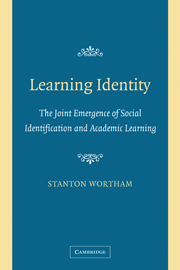Book contents
- Frontmatter
- Contents
- Acknowledgements
- 1 Self/Knowledge
- 2 Social Identification and Local Metapragmatic Models
- 3 Academic Learning and Local Cognitive Models
- 4 Tyisha Becoming an Outcast
- 5 Maurice in the Middle
- 6 Denaturalizing Identity, Learning and Schooling
- Appendix A Abbreviations of Names
- Appendix B Transcription Conventions
- References
- Index
2 - Social Identification and Local Metapragmatic Models
Published online by Cambridge University Press: 05 June 2012
- Frontmatter
- Contents
- Acknowledgements
- 1 Self/Knowledge
- 2 Social Identification and Local Metapragmatic Models
- 3 Academic Learning and Local Cognitive Models
- 4 Tyisha Becoming an Outcast
- 5 Maurice in the Middle
- 6 Denaturalizing Identity, Learning and Schooling
- Appendix A Abbreviations of Names
- Appendix B Transcription Conventions
- References
- Index
Summary
In classrooms, the processes of becoming an identifiable type of person and learning the curriculum can mesh with one another. In order to analyze more precisely how this happens, we need specific accounts of social identification and academic learning. This chapter develops an account of social identification and Chapter 3 develops an account of academic learning. Drawing on these accounts, Chapter 3 goes on to describe how the two processes can be woven together, as happened in Mrs. Bailey and Mr. Smith's classroom. Chapters 4 and 5 analyze in detail how these two processes meshed over the year as Tyisha and Maurice developed their distinctive classroom identities.
This chapter first sketches a conceptual account of social identification. Resources at several timescales make essential contributions to social identification. An individual's social identity depends ultimately on phenomenally perceivable signs of identity given off in particular events. However, participants enact and interpret perceivable signs of identity only as they draw on models of identity that circulate more widely across time and space. In addition to event-level and sociohistorically circulating resources, social identification also depends on resources from intermediate timescales. In the classroom examined here, local models of identity emerged over several months and made key contributions to some students' identities. After developing this account of the heterogeneous resources that contribute to social identification, the chapter describes models of identity that crystallized in Mrs. Bailey and Mr. Smith's classroom over the academic year, focusing on the gendered categories of promising girls and unpromising boys.
Information
- Type
- Chapter
- Information
- Learning IdentityThe Joint Emergence of Social Identification and Academic Learning, pp. 29 - 89Publisher: Cambridge University PressPrint publication year: 2005
